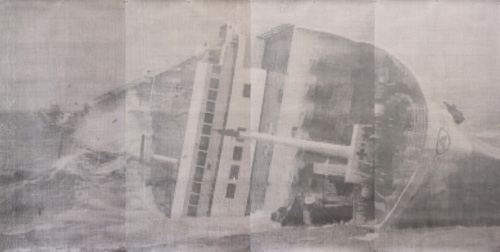
Katsutoshi Yuasa. “Pseudo Mythology #3,” 2011. Oil-based woodcut with pigment on Shin Torinoko paper. 95 ½ x 192 inches. Edition of 2, printed and published by the artist. Image courtesy the artist and TAG Fine Arts, New York and London.
Katsutoshi Yuasa’s first solo exhibition in the US (at the ISE Cultural Foundation, New York, through January 4) demonstrates an utterly fresh approach to relief printing, grounded in the wider dialogue of contemporary art and culture. The artist’s meticulous translations of photographs into woodcut offer meditations on humankind’s relationship the natural world, while simultaneously provoking questions of cultural amnesia, memory, and perception. His ongoing Pseudo Mythology series, which explores both natural and man-made disasters/forces, feels particularly relevant in the wake of recent events in the US and Japan.
Yuasa’s source photographs range from the mundane (trees) to the sensational (an overturned tanker) and are culled from his own digital camera as well as the internet. Through the process of converting these images to black-and-white, enlarging, transferring, carving, and finally printing the block in a single tone, Yuasa transforms them from the “fact” of a snapshot into a more subjective representation of how such images are understood and processed by the mind. The final product is recognizable but distorted and flattened, as if through a haze. The works, which range in scale from medium to outsized, are mounted directly to the wall without mediation between viewer and sheet. This allows for a total immersion in the image, as well as a palpable immediacy to the pristinely printed surface, calling attention to its illusionistic qualities.
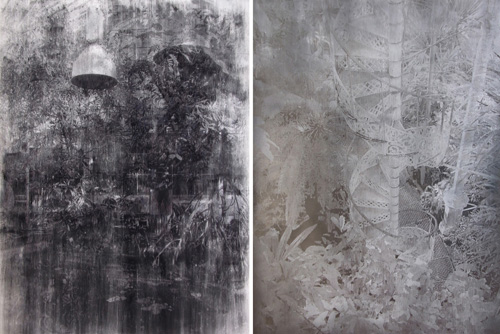
Katsutoshi Yuasa. “An Impossible Extreme Reality #1” (left); “An Impossible Extreme Reality #2” (right), 2012. Oil-based woodcuts on Sirius (#1) and Fabriano (#2) papers. Each 64 ¼ x 48 inches. Editions of 5, printed and published by the artist. Image courtesy the artist and TAG Fine Arts, New York and London.
In terms of theme, the works explore the complexities of our connection to nature as a whole, from flowers to natural disasters. The diptych An Impossible Extreme Reality #1 – #2 shows the interiors of two separate greenhouses – each so grand in scale as to contain an oversized ventilation system on one hand (#1), or a metalwork spiral staircase and walkway on the other (#2). Their complex layers of foliage provoke a pleasurable response, but this is counteracted with a sense of foreboding invoked by Yuasa’s mark-making and choice of materials. The black ink and white paper of Impossible Extreme Reality #1, which travels down the sheet in undulating vertical lines that streak and melt, conveys a sense of anxiety and decay. Impossible Extreme Reality #2 is also carved in vertical lines that vary in width, yet the effect is quite different – the printing is more controlled and even, almost synthetic, and occasionally dissipates into atmospheric clouds; the overall effect is one of toxicity and artifice.
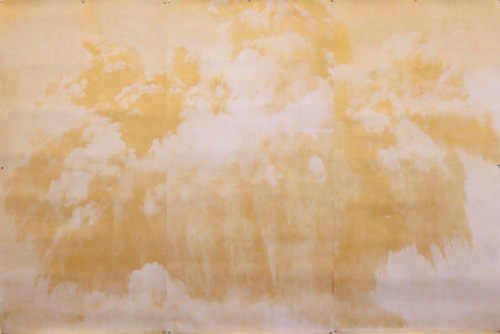
Katsutoshi Yuasa. “Pseudo Mythology #2,” 2011. Oil-based woodcut with pigment on Shin Torinoko paper. 95 ½ x 14 inches. Edition of 3, printed and published by the artist. Image courtesy the artist and TAG Fine Arts, New York and London.
Yuasa’s aforementioned Pseudo Mythology works–which were debuted at ASPN Gallery, Leipzig, last year–is represented in three examples here. As explained by curator Diana Ewer, the ongoing series came about in response to Yuasa’s experience with the 2011 Tōhoku Earthquake and Tsunami, during which he was living in Germany. Like many displaced natives of Japan, he was unable to reach friends and family for a time and his only source of information was the images, articles, and firsthand accounts posted on the internet – an ultimately unsatisfying and removed relationship to an event that held such personal implications. The form and scale of Pseudo Mythology #3 (illustrated top) encapsulates the distortion, displacement, and overwhelming nature of the artist’s experience while simultaneously transcending it, to the universal. The image of a toppled ship comes in and out of focus – it is recognizable but lacking in detail or specificity – it could be the ocean liner that sank earlier this year off the coast of Italy, an image from the 2011 tsunami, or another event (in fact, it is from a 2009 tsunami in the south of Japan). Its grid-like pattern, which is a clear referent to the digital source image, spurts and stutters across a vast expanse of pristine white paper, engulfing the viewer in a sea of silver spray. Nearby, Pseudo Mythology #2 – a seductive and warm Ganzfeld of gold tone – first appears to be a pleasantly atmospheric image of clouds, then slowly reveals itself to be an unidentifiable explosion; either a volcano or mushroom cloud. Likewise, Pseudo Mythology #4 (Nebula), an image of the heavens, beckons and charms with a shimmering surface of graphite. However, in this context the image provokes meditation on the catastrophic nature of the explosion depicted: only with the privilege of remove can an event of this sort be beautiful.
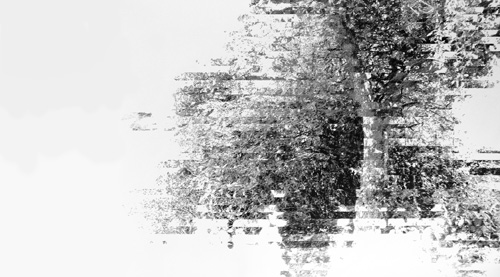
Katsutoshi Yuasa. “Interrupted Recognition,” 2011. Oil-based woodcut with pigment on Shin Torinoko paper. 24 x 97 ¾ inches. Edition of 5, printed and published by the artist. Image courtesy the artist and TAG Fine Arts, New York and London.
Yuasa’s talent for lending an ominous overtone to his subject matter is perhaps best revealed in his more banal subjects: a tree, a forest, a lake. Interrupted Recognition, a highly distorted image of a tree that plays across the sheet in staggered bands, plays to the role of technology in our increasingly mediated and artificial relationship to the natural world. Slow Screaming #1 – #3, is a series of menacing forest images that could easily pass as film stills from The Blair Witch Project. Likewise, the panoramic diptych Listen, Nature is Full of Songs and Truth – a mirror-like lake surrounded by birch trees – spreads across a wide surface in the deepest black, punctuated with veins of white, then ends abruptly with a useless man-made structure that rousts the viewer from any pretense of idyll.
The exhibition also includes a handful of unique works that are more intimate and poetic in nature and demonstrate the exploratory nature of Yuasa’s artistic practice. We Have to Wrestle Anxiety, Chagrin and Sorrow But we Survive Every Day with Smiles (watercolor overlaid with woodcut) is an elegy for the victims of the earthquake and the grief of the survivors. Pictures of Colors (inkjets with hand-applied pigment) continue an ongoing dialogue first explored by the Impressionists on the nature of light refraction on the surface of water – here brought into sharp focus due to the photographic basis of the imagery.
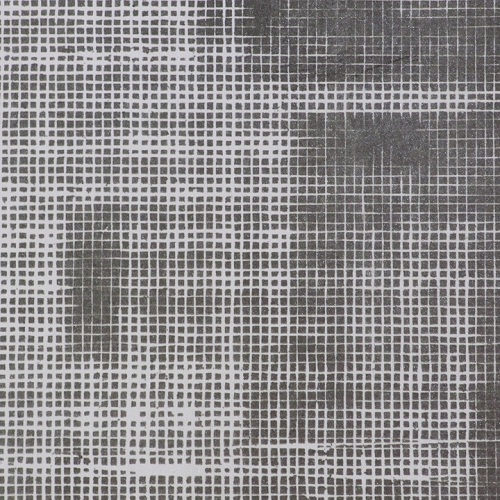
Katsutoshi Yuasa. “Pseudo Mythology #3” (detail), 2011. Oil-based woodcut with pigment on Shin Torinoko paper. 95 ½ x 192 inches. Edition of 2, printed and published by the artist. Image courtesy the artist and TAG Fine Arts, New York and London.
As discussed in a brief essay by the scholar Kohei Kuwada in the exhibition catalogue, Yuasa’s work represents a “re-birth” of the traditional Japanese approach to woodcut. Kuwada outlines Yuasa’s interest in the medium as a mode of exploring the realm of perception, representation, and memory in relationship to photography, particularly with regard to Structuralism and Semiotics and the theories of Foucault and Barthes. In keeping with this philosophical foundation, Yuasa’s mark-making varies from series to series, exploring an array of approaches that have been traditionally used for commercial reproductive imagery. As previously mentioned, An Impossible Extreme Reality #1 and #2 are comprised entirely of thin vertical lines of variable width – a technique that was common in the nineteenth century when wood engraving was the primary medium for mass-produced imagery. On the opposite end of this historical spectrum, the artist mimics the pixilation of digital imagery for his Pseudo Mythology series (detail above). Other prints echo the distortion and noise that occasionally interrupt television viewing, referencing either the “snow” of the now-defunct analogue technology or the shifting horizontal bands of current digital/HD (see Interrupted Recognition, above).

Katsutoshi Yuasa at work. Image courtesy the artist and TAG Fine Arts, New York and London.
Though Yuasa has great respect for craftsmanship and his technique is very much grounded in the twentieth-century Sōsaku-hanga or “creative prints” movement that still dominates much printmaking activity in Japan (he carves his own blocks with traditional tools and hand-prints his work in small editions of 2-5 using a Japanese baren), the similarities end there–Yuasa’s choice of medium is informed by his ideas as an artist, rather than the other way around. In an interview with Ewer (also in the catalogue), Yuasa distances himself from the more technically-minded practice of printmaking, instead emphasizing its function as a means of communication and a medium for the dissemination of information, stating that the conversation should center on “philosophy and ideology…we need to talk about printmaking without technique.”
In its engagement with theories surrounding perception and representation, Yuasa’s work is best understood as an essential voice in the global contemporary art dialogue, where printmaking has become an increasingly important medium due to its foundations in mass-media and communication. In this context, Yuasa’s conceptual approach provides an essential counterpoint to the more expressionistic use of relief printing by artists such as Dennis McNett and Tom Huck, who also work on a monumental scale and base their technique in tradition (albeit, that of Western Art). As such, Yuasa’s work suggests an entirely new avenue of exploration for this most ancient of techniques.
Editor’s note: Sarah Kirk Hanley will be on leave from January through April of 2013. In her place, a series of guest writers will be authoring Ink: Notes on the Contemporary Print.



